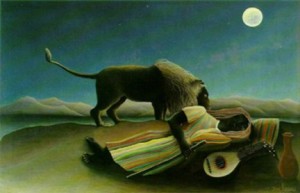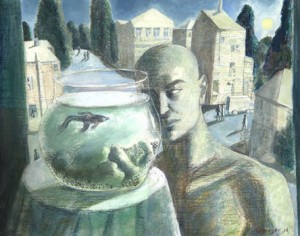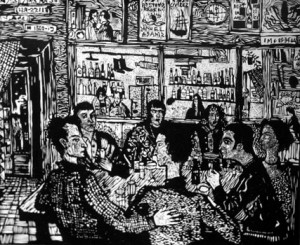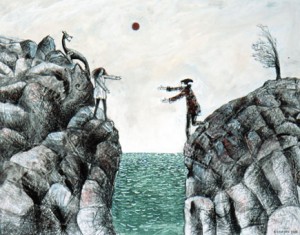This is the first in an ongoing series of interviews with artists who are making a living through their art and complimentary careers (or ‘day jobs’) that encourage their creativity and artistic expression. If you are an artist and are interested in being interviewed as part of this project, please visit our contact page.

Hi Alex! Tell us about your art. What’s your medium, how long you’ve been doing it?
I am a printmaker and a painter. I make linoleum block prints and acrylic painting and drawings on paper. I started when I was 12, so this means I have been making art for 22 years.
How was your training in Russia different than that of your contemporaries in the USA?
In Russia we had very conservative training. We studied the masters and you weren’t allowed to do your own thing until you graduated. When you looked at the work during reviews or exhibits, you couldn’t tell who created it. It was all supposed to look exactly the same. Very uniform. And when you graduated you were left thinking what do you really want to do because all you learned was to draw like someone else.
Here, people have a lot of ideas, but they can go through art school without knowing how to draw. I think the ideal is probably somewhere in between.
Whose work inspires you?

I like strong imagery. Albrecht Durer,
Pieter Bruegel the Elder, Hieronymus Bosch, Henri Rousseau, Edward Gorey. I love good movies like Once Upon a Time in America, and work listening to the Russian music I grew up with. A lot of my ideas come from watching real people in the real world. My work might not look like it, but everything I create comes out of real life. Inspiration comes from fresh air.
I have my own small business doing graphic design.
I have a handful of graphic design clients who keep me busy. I work out of my home. I also have a studio next to my office. Usually, in the morning, I check my email and see what needs to be done and take care of any urgent business. I work on book covers, annual reports, case studies. I check in with clients and am able to make myself available though out the day if they need me, 7 days a week and even on holidays which is very valuable to them. They can send me work on Friday and get it back on Monday, even over the July 4th weekend. Some people think that this is strange, but really I have so much flexibility in my work life that I don’t feel like I am losing out on these things. I didn’t come to this world to eat hamburgers and hotdogs anyway. And when I have a light workload, it is easy for me to shift my focus to my own work.
How did you get into this job?
I left a full-time job as a graphic designer to work for myself and be at home with our son. It was scary at first, but I had some contacts who liked my design and were willing to work with me.
How does this job compliment your art and other creative endeavors?
It is creative work. Even though I spend a lot of time on the computer, I sometimes get to use

my own illustrations. I also have a lot of clients who are running creative organizations, so I get to work on some interesting collaborations.
In my own work, I use a very traditional, labor intensive technique and sometimes it takes me up to 6 months make a print. I use a lot of detail. And in my own work I like black and I like white. My design projects use a lot of color. Maybe because on the computer colors are free.
I’ve also been showing a lot in Seattle lately, and at a job I would never have had the flexibility to go back and forth from the East Coast to the West as often as I have this past year.
Tell us about your family and how your art & day job affect them.

My wife Jamie and I both work out of our home and have our son with us. We are very happy that we can take time to play during the day, or go to the beach, even if that means we may spend some time working on the weekends or late at night. My son always tells everyone that Papa is an artist and Mama has a job, maybe because she is on the phone a lot.
Jamie has been supportive every step of the way. It is really important to find someone like that.
My family is also in a lot of my artwork. When Jamie had a job a few years back and invited all of her coworkers one of my shows, one of them stopped her and asked her if she realized she was naked in half of the work.
I like to work on paintings and prints alone, but when it is time for a show, we do everything together. My son loves to go to the frame shop with me, and he’ll make art for me to bring to my shows in case I don’t have enough of my own work. He recently saw me working on my Eiffel Tower print and he did a few tower drawings of his own for me to use so that I wouldn’t have to stay up so late working. He has been attending my shows since he was an infant, so being around art and talking about art is just part of his life. He makes a lot of art himself.
We really enjoy our days together. We get to grocery shop with old people in the morning. We don’t have much money to spare, but we have our good times.
What is one thing about your current career that you didn’t anticipate when you were younger? How did your career evolve in ways you didn’t expect?
In Russia, if you are an artist you are given a studio from the government-run Union of Artists. Then I moved to America, where nothing is free.
When I was younger I thought people would buy my prints for $100,000 and be fighting for more. I’m still hoping that will happen someday, but we do have bills to pay in the meantime.
Have you ever been accused of ‘selling out?’ What does the term ‘selling out’ mean to you?
Selling out is when you start exhibiting your work and some type of work sells more than  others and you choose to create that kind of work rather than doing what is important to you. I haven’t been accused of that.
others and you choose to create that kind of work rather than doing what is important to you. I haven’t been accused of that.
If you could give other artists advice about money or getting started in their career, what would you say?
If the artist, straight out of college, starts exhibiting and is selling out of galleries that is great. But I think it is also great if you are able to find commercial work on the side and take time to find your own style and your own clear mark so that when people see your work they know it is yours. That is more important than selling what sells.
You can find out more about Alex, and see more of his work, by visiting AlexGerasev.com.
Very talented! So interesting about moving from Russia to US, where things aren’t free. I’ve heard about people finding themselves in that situation. 6 months to finish a print: you have great patience!!! Wow. Glad you get to stay home w/son, that’s a special time.
.-= Gabrielle Valentine´s last blog ..Just Call Her Laura Ingalls. =-.
Great interview. I always find it very interesting to learn about an artist’s history and how s/he came to be where they are in their professional life.
I studied printing with linoleum blocks some time ago and I still do it occasionally, however it is definitely not my strong suit. I am now an aspiring painter focused on watercolors.
Thank you for telling Alex’s story.